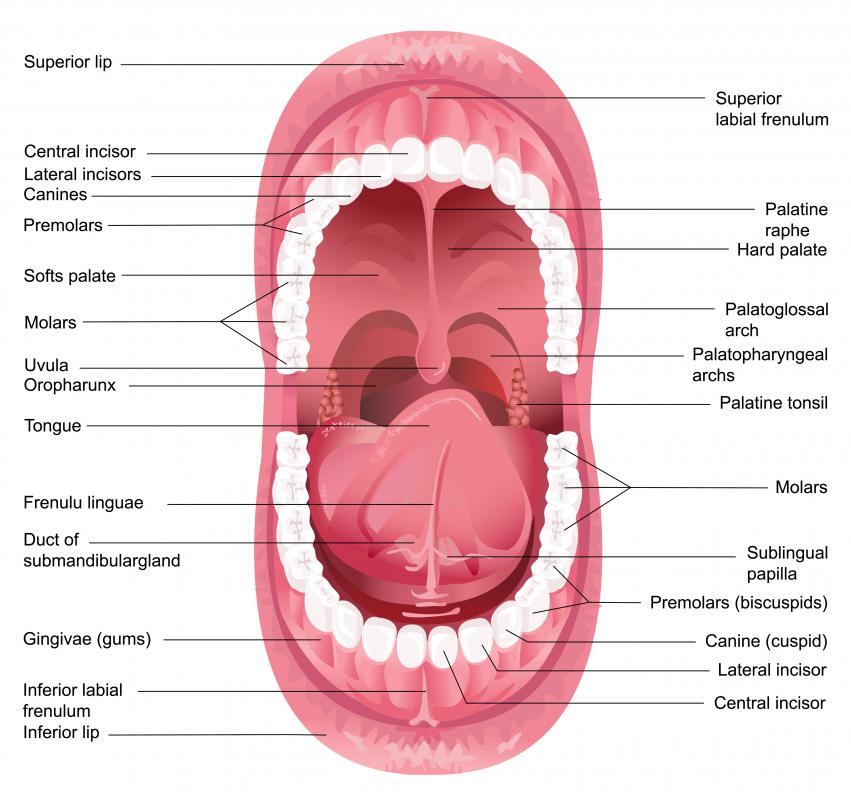At WiseGEEK, we're committed to delivering accurate, trustworthy information. Our expert-authored content is rigorously fact-checked and sourced from credible authorities. Discover how we uphold the highest standards in providing you with reliable knowledge.
What is an Incisor?
The incisors are sharp, chisel-like teeth used for grasping, cutting, and gnawing food during chewing. In humans, there are eight incisor teeth located at the front of the mouth. Many other animals have incisor teeth as well.
The two sets of incisors on the top of the mouth are called the maxillary central incisors and maxillary lateral incisors. The central incisors are those closest to the midline of the body, while the lateral incisors are distal, or further from the midline. The maxillary incisors attach to the maxillary, or upper jaw. Attached to the bottom jaw, or mandible, are the mandibular central and lateral incisors.

Primary or deciduous incisors grow in the mouth during infancy. These are replaced by secondary or permanent incisors in childhood. Each incisor is attached to the jaw with one, long cone-shaped root per tooth. The front, or outward facing side, of the tooth is smooth and polished with a convex shape. The back, or inward facing side of the tooth, has a concave shape, and the upper incisors have a v-shaped ridge at the top of the tooth near the maxillary arch.

There are several different systems for labeling the teeth in the human jaw. The universal notation system, which is commonly used in the United States, labels deciduous teeth by assigning each one a capital letter. Permanent teeth are labeled according to number. The upper deciduous teeth, from the patient's right to left, are labeled D, E, F, and G. The upper permanent teeth are accordingly labeled 7, 8, 9, and 10. The lower deciduous teeth from patient's left to right are N, O, P, and Q, while the permanent teeth are 23, 24, 25, and 26.

The FDI World Dental Federation developed a two-digit notation used by dentists internationally. This system labels both deciduous and permanent teeth by number. Deciduous incisors, from patient's right to left are 52, 51, 61, and 62 while the permanent teeth are 12, 11, 21, and 22. Lower deciduous incisors are, from right to left, 82, 81, 71, and 72. Permanent teeth are 42, 41, 31, and 32.
In addition to humans, this type of tooth is found in herbivores, those who eat only plants, like rabbits. It is also found in other omnivores, or those who eat both plants and meats. Some omnivores that have incisor teeth are horses, cats, and rodents.
Horses and cats have 12 incisors, while rodents only have four. These teeth are different in rodents, because they continue to grow throughout the animal's life and are worn down by the gnawing action when it eats. In elephants, the upper incisors have evolved into curved tusks.
AS FEATURED ON:
AS FEATURED ON:













Discussion Comments
@kentuckycat - I think that the incisors may have a tendency to break more than other teeth simply because of its density.
Canine teeth are designed to rip, just like a dog, and they are a lot thicker than the incisors. Same thing goes for the molars which really are supposed to chew the meat and help with swallowing.
I think one factor that may play a role is the amount of incisors there are. Just having more in numbers means that there is more of a chance that the incisor will probably break before a molar or a canine tooth.
I have always though that the incisors were the most brittle of the teeth. I have a very healthy mouth, but every problem I have ever had with my teeth has had to do with my incisors.
It could just be that there are so many more incisors than other teeth, or the fact that they are all thinner than the canine teeth or molars, but I feel that these teeth are more susceptible to injury and damage than other teeth in the mouth.
@cardsfan27 - I think that you are looking too much into the name itself. I go not bite food with the front of my teeth either, but I do chew with them to an extent so I can see them being called incisors.
Maybe back when they decided on the name they were simply trying to find something to call it, but as far as the way you are looking at it, it seems to me like you like to study the origin of words and should probably look into studying them in a classroom. Things like the name of a tooth make you wonder why they called it what they did.
I have always thought that incisor teeth were the same thing as canine teeth but I guess I was wrong. This may have something to do with what incisor means, which is Latin for "to cut."
I have to wonder though why are the teeth in front considered the incisors while the canine teeth are in reality the ones that do most of the cutting when someone chews?
I guess this could simply be something of a matter of opinion but I never chew with the front of my teeth. I do not know maybe my way of eating is just different than other people.
Post your comments